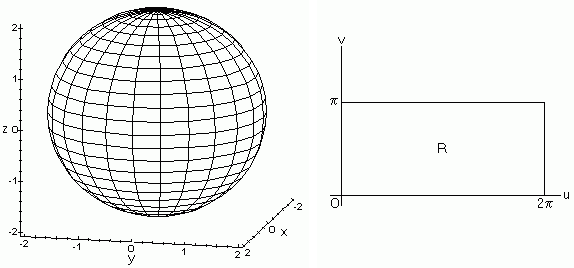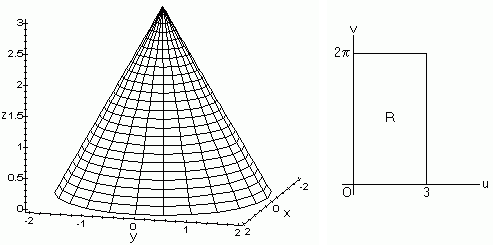As we have seen previously, z=f(x,y) describes a surface in xyz space. Alternatively, a surface can be described in parametric form:
![]()
where the points (u,v) lie in some region R of the uv plane.
Let us compare and contrast the parameterization of a surface with that of a space curve. A space curve is described by the vector function:
![]()
where a<=t<=b. A space curve is a one-dimensional object, similar to a piece of string. Each coordinate x,y and z depends only on one parameter, t. Each point on the curve corresponds to a different value of t.
A surface is a two dimensional object. One needs TWO pieces of information to uniquely define a point on a surface. These two pieces of information are the parameters u and v. These notions will hopefully become clearer as you go through the examples below.
Examples
A natural example is a sphere. It takes two pieces of information to describe a point on a sphere: the latitude and longitude. Let u, with 0<=u<=2*pi be the longitude. Let v, with 0<=v<=pi be the latitude. Here u and v correspond, respectively, to the the spherical coordinates theta and phi. Using the formulas for spherical coordinates we have
![]()
Here a is a constant, not a variable.

This is an example of surface that CANNOT be described by a single function z=f(x,y). A sphere of radius a centered at the origin can be defined by the relationship
![]()
The top half of the sphere is defined by the surface
![]()
and the bottom half is the defined by the surface
![]()
A second example is a cone, as shown in the figure. The height is 3, the base radius is 2, and the cone is centered at the origin.

Two parameters are required to define a point on the surface. We choose them to be u, the height from the base, and v, the angle with respect to the x-axis. v is the same as the polar angle theta. We can describe any point on the surface by:
![]()
0<=u<=3, and 0<=v<=2*pi. Here r is the radius, the same as the variable in polar coordinates. The variable r must be eliminated since it is a third parameter.
For a cone the radius and the height from the base are related by a linear function. In this example, the radius is 2 when the height is 0 and is 0 when the height is 3. If we let u denote the height, r=2-2u/3. Hence, we have
![]()
Copyright © 1996 Department of Mathematics, Oregon State University
If you have questions or comments, don't hestitate to contact us.